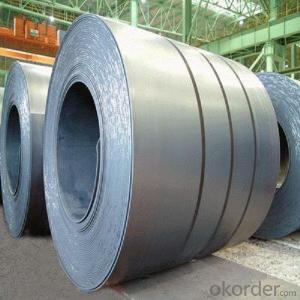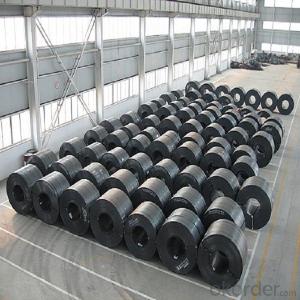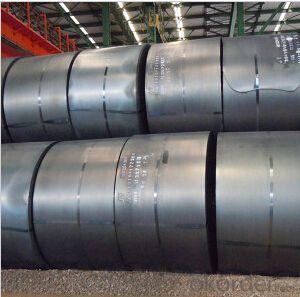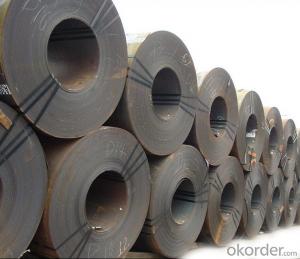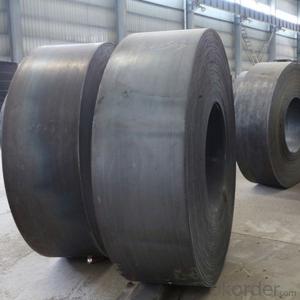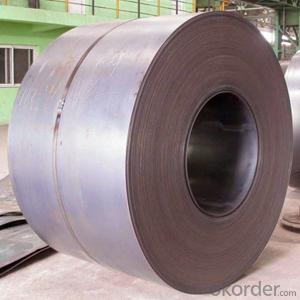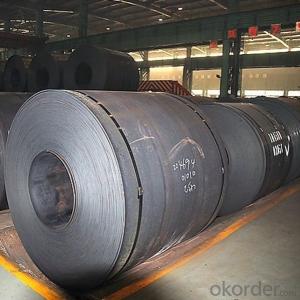Hot Rolled Carbon Steel Coil (1.0mm-1.1mm SS400)
- Loading Port:
- China main port
- Payment Terms:
- TT OR LC
- Min Order Qty:
- 20 m.t.
- Supply Capability:
- 50000 m.t./month
OKorder Service Pledge
OKorder Financial Service
You Might Also Like
Specification
Detailed Product Description
Hot rolled steel coil
Material:Q195,Q235,SS400,SM400(A.B),S10C-S55C,ST37-2,ST37-3,1010-1050,S235(JR.J0.J2G3.J2G4)
Thickness: 1.0-1.1mm
Width: 1000-1500mm
Application: Widely used in construction, household appliance, automobile, light industry, etc
Other: Hot Dipped Galvanized Steel Coil
| Grade | Chemical Composition | ||||
| C | Si | Mn | S | P | |
| Q235A | 0.14-0.22 | 0.17-0.30 | 0.35-0.65 | ≤0.050 | ≤0.045 |
| Q235B | 0.12-0.20 | 0.17-0.30 | 0.35-0.67 | ≤0.045 | ≤0.045 |
| Q235C | ≤0.18 | 0.17-0.30 | 0.35-0.80 | ≤0.040 | ≤0.040 |
| Q235D | ≤0.17 | 0.17-0.35 | 0.35-0.80 | ≤0.040 | ≤0.035 |
| technical property | tensile strength | elongation | yield strength | hardness | reduction area |
| ≥420MPa | 25% | ≥250MPa | ≥156HB | ≥55 | |
Export packing
Shipment
Useing
FAQ
1. Q: What's the MOQ?
A: Our MOQ is 25mt.
2. Q: What's the delivery time?
A: It will take about 30 days after TT or L/C.
3. Q: What is the payment terms?
A: T/T, L/C at sight
4. Q: How does your factory carry out quality control?
A: We attach great importance to quality control.Every part of our products has its own QC.
5. Q: What certificate do you have?
A: We have SGS, ISO9001 etc. Also we can apply any certificate if you need if the qty is OK.
- Q: How do steel coils contribute to sustainability efforts?
- There are several ways in which steel coils contribute to sustainability efforts. Firstly, steel is a material that can be recycled and reused multiple times without losing its quality or strength. This reduces the need for virgin steel production, which is a process that requires a lot of energy and has a negative impact on the environment. By incorporating recycled steel coils into manufacturing processes, companies can significantly reduce their carbon footprint and conserve natural resources. In addition, steel coils are known for their long lifespan and durability. This means that products made using steel coils, such as automotive parts, construction materials, or appliances, also tend to last longer. This reduces the need for frequent replacements, which in turn reduces waste generation and conserves resources. Moreover, advanced technologies can be used to manufacture steel coils in a more energy-efficient way, resulting in reduced greenhouse gas emissions. Steel manufacturers are increasingly adopting sustainable practices, such as using energy-efficient furnaces, optimizing production processes, and implementing recycling initiatives. These measures help minimize the environmental impact of steel production and contribute to overall sustainability efforts. Furthermore, steel coils are widely used in the construction industry, which plays a vital role in sustainable development. Steel is a crucial component in the construction of energy-efficient buildings and infrastructure, such as green buildings and renewable energy projects. These structures are designed to minimize energy consumption, reduce emissions, and promote resource efficiency. By using steel coils in these sustainable construction projects, the industry can contribute to a greener and more sustainable future. In conclusion, the recyclability, durability, energy-efficient manufacturing processes, and role in sustainable construction make steel coils a valuable contributor to sustainability efforts. By choosing steel coils and promoting their use, companies and industries can reduce their environmental impact, conserve resources, and contribute to building a more sustainable society.
- Q: How are steel coils inspected for coil set?
- Steel coils are inspected for coil set by uncoiling a portion of the coil and measuring the amount of curvature or shape deviation. This is done using specialized equipment and techniques to accurately assess and quantify the coil set present in the steel coils.
- Q: How are steel coils inspected for oil or rust residues using chemical analysis?
- Chemical analysis techniques can be employed to inspect steel coils for the presence of oil or rust residues. One widely used method is Fourier transform infrared spectroscopy (FTIR), which involves subjecting a small sample of the steel coil to infrared radiation and analyzing the resulting infrared spectrum. By identifying specific chemical bonds indicative of oil or rust residues, this technique can effectively detect their presence. For oil residue detection, a common approach is to examine the FTIR spectrum for a peak at approximately 2920 cm-1, which corresponds to the stretching vibration of C-H bonds in hydrocarbon chains. The observation of this peak signifies the existence of oil residues on the steel coil. To identify rust residues, the FTIR spectrum is scrutinized for characteristic peaks associated with iron oxide or hydroxide compounds. For instance, the presence of a peak at around 560 cm-1 suggests the presence of iron oxide (FeO) or iron hydroxide (Fe(OH)3). Apart from FTIR analysis, other chemical analysis techniques like X-ray fluorescence spectroscopy (XRF) or energy-dispersive X-ray spectroscopy (EDX) can also be employed. These methods provide information about the elemental composition of the steel coil, enabling the identification of specific elements linked to oil or rust residues, such as carbon or iron. In essence, the chemical analysis of steel coils for oil or rust residues offers a dependable and precise means of ensuring the coils' quality and cleanliness before further processing or utilization.
- Q: How are steel coils used in the manufacturing of aerospace components?
- Steel coils are used in the manufacturing of aerospace components primarily for their strength, durability, and ability to withstand high temperatures. These coils are typically formed into various shapes and sizes to create structural parts like fuselage frames, landing gear components, and engine mounts. The steel coils provide the necessary strength and rigidity to ensure the structural integrity of these aircraft components, making them essential in the aerospace industry.
- Q: and also what makes different hardness of stainless steel?
- Stainless steel is formed due to other metals present, that are resistant to corrosion. The main one is chromium, which is an excellent protector. Hardness in steel is due to other metals, as well as the carbon content. Chromium, vanadium and tungsten make steel extraordinarily hard. High carbon content makes steel hard but brittle.
- Q: I have to explain some functions of stainless steel but after days of searching I cant find an answer. Thankyou in advance for your help :)
- www.okorder
- Q: What are the common methods of protecting steel coils from corrosion during storage?
- There are several common methods used to protect steel coils from corrosion during storage. These methods are employed to prevent moisture and other environmental elements from coming into contact with the steel coils, which can lead to corrosion. 1. VCI (Volatile Corrosion Inhibitor) Packaging: VCI packaging is a widely used method for protecting steel coils. VCI materials are incorporated into the packaging, such as plastic bags or films, which release a vapor that forms a protective layer on the surface of the steel coils. This layer prevents moisture and other corrosive agents from reaching the steel, thus inhibiting corrosion. 2. Oil Coating: Another widely used method is to apply a thin layer of oil on the surface of the steel coils. The oil acts as a barrier, preventing moisture and oxygen from coming into contact with the steel. This method is particularly effective for long-term storage or transportation of steel coils. 3. Desiccants: Desiccants, such as silica gel packets, can be placed inside the packaging to absorb any moisture that may be present. By reducing the humidity levels inside the packaging, the risk of corrosion is minimized. This method is often used in conjunction with VCI packaging or oil coating. 4. Proper Ventilation: Adequate ventilation is necessary to prevent the accumulation of moisture around the steel coils during storage. By allowing air to circulate freely, it helps to reduce the humidity levels and prevents the formation of condensation, which can lead to corrosion. 5. Controlled Environment: Storing steel coils in a controlled environment can be an effective way to prevent corrosion. This involves maintaining a constant temperature and humidity level, which are not conducive to corrosion. Temperature and humidity control can be achieved through the use of air conditioning or dehumidification systems. It is important to note that the specific method or combination of methods used to protect steel coils will depend on various factors, such as the duration of storage, the environmental conditions, and the specific requirements of the steel coils. Regular inspections and maintenance are also crucial to ensure the ongoing protection of the steel coils from corrosion.
- Q: What are the different packaging options for steel coils?
- There are several packaging options for steel coils, including wooden crates, steel frames, and metal or plastic bands. These packaging options help to protect the coils during transportation and storage, ensuring their integrity and preventing damage.
- Q: We have to do a project for school on steel mines and i need 4 PROPERTIES OF A STEEL MINE PLEASE HELP!!! URGENT!!!
- There's no such thing as a Steel mine - steel is made from various raw materials (and now recycled metals). These materials may be mined separately and then combined at a steel mill - but steel is made, not mined. Steel, depending on what final characteristics they're trying to develop (strength, hardness, finish , etc.) can be comprised of iron, carbon, manganese, phosphorus, sulfur, nickel, chromium, etc. in varying quantities.
- Q: Cooling bed generally a part of the steel rolling mills
- In the USA, a steel cooling bed is called a run-out table. It consists of a series of steel rolls. Each roll may be individually driven by an electric motor. DC motors are often used with parallel armatures connected to a common armature voltage control speed control unit. The roll speed is controlled to match the speed of the incoming sheet of steel so that the steel does not slide or skid on the surface of the rolls. Field trim resistors help to assure that the speed and torque of rolls is matched. A centering mechanism may be used to keep the steel in the center of the table. Water may be sprayed from the top and bottom to aid cooling. After an initial run out table, the strip of steel may be cut on-the-fly into individual sheets which pass to another table that is running slightly faster to separate the sheets. Alternatively, the steel may be coiled at the end of the table.
Send your message to us
Hot Rolled Carbon Steel Coil (1.0mm-1.1mm SS400)
- Loading Port:
- China main port
- Payment Terms:
- TT OR LC
- Min Order Qty:
- 20 m.t.
- Supply Capability:
- 50000 m.t./month
OKorder Service Pledge
OKorder Financial Service
Similar products
Hot products
Hot Searches
Related keywords
